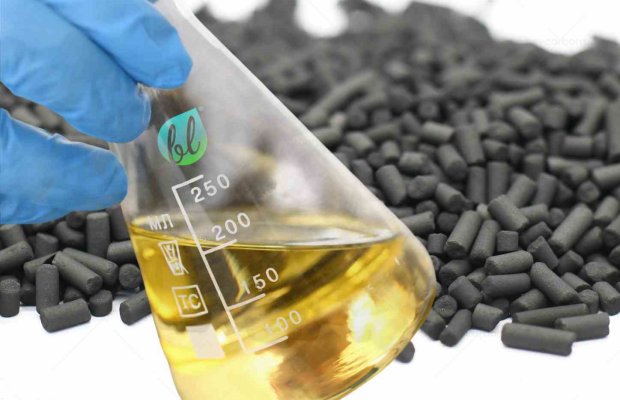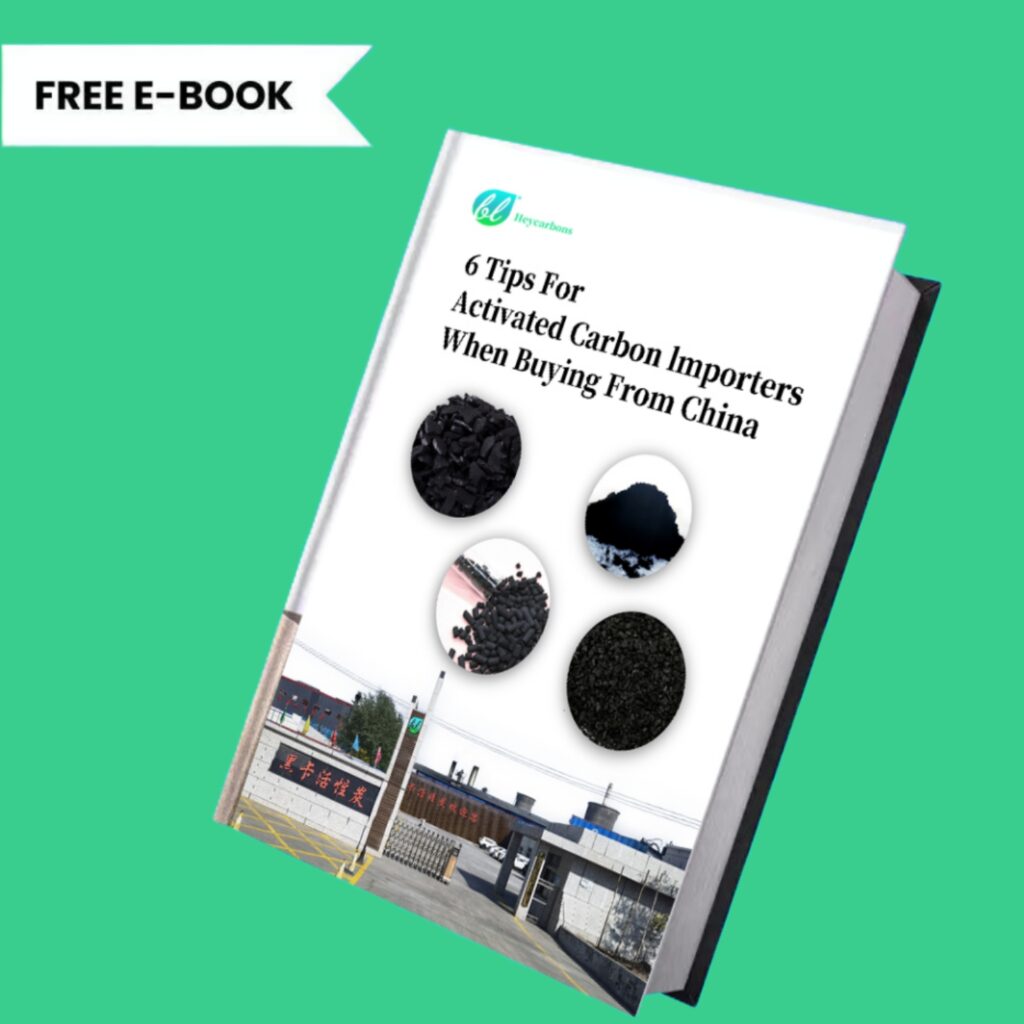Phosphoric Acid H3PO4 and Nitric Acid HNO3 Impregnated Activated Carbon
Acidic Impregnated Activated Carbon Introduction
Activated carbon impregnated with acidic compounds (such as nitric acid HNO₃, phosphoric acid H3PO4, sulfuric acid H₂SO₄, hydrochloric acid HCl, hydrofluoric acid HF) is called acid impregnated activated carbon.
Impregnation with acidic compounds can improve the surface properties of activated carbon and enhance its adsorption capacity for alkaline substances. It can effectively adsorb alkaline pollutants in water and air.
This article mainly introduces phosphoric acid H3PO4 and nitric acid HNO3 impregnated activated carbon.
You will get a quote in 24 hours

How to Impregnate Activated Carbon?
Acidic impregnated activated carbon production process is as follows.
Preparation: Select the appropriate basic activated carbon according to customer requirements, and dissolve water and acidic compounds (phosphoric acid H3PO4, nitric acid HNO₃) in a certain proportion.
Impregnation: After the acidic impregnated activated carbon is prepared, the dissolved chemical solution is evenly sprayed on the activated carbon. This method replaces soaking, greatly improves production efficiency and reduces water content.
Heat release: Before packaging, the impregnated activated carbon is placed at room temperature for about two days to release heat, which can improve safety.

You will get a quote in 24 hours
You will get a quote in 24 hours
Acidic Impregnated Activated Carbon Uses
What is acid impregnated carbon used for?
Why is phosphoric acid used in activated carbon?
Phosphoric acid H3PO4 and nitric acid HNO3 impregnated activated carbon can be used to remove ammonia NH3, ethylene oxide EO, adsorb heavy metals, and act as a catalyst carrier.
You will find out detailed phosphoric acid H3PO4 and nitric acid HNO3 impregnated activated carbon uses below.
Ammonia NH3 Removal
- Based carbon: Use 40-80 activated carbon impregnated with phosphoric acid H3PO4
- Phosphoric acid H3PO4 concentration: 50%
- Content: 5~10% (if the proportion of carbon tetrachloride is high, the content can be reduced)
- Function:
1. The phosphoric acid-impregnated activated carbon will have phosphoric acid groups (PO43−) or phosphates on its surface, and ammonia reacts with these groups to form ammonium phosphate salts ((NH4)3PO4). Phosphoric acid impregnated activated carbon formula is as follows: NH3(g)+H3PO4(s)→(NH4)3PO4(s)
2. If phosphoric acid has more acidic sites, ammonia can be adsorbed by generating ammonium ions (NH4+) through acid-base reaction. Reaction formula is as follows: NH3(g)+H+→NH4+(aq)
3. At higher temperatures, phosphoric acid-impregnated activated carbon has a catalytic effect, promoting the oxidation reaction of ammonia to produce nitrogen (N2) and water (H2O). Phosphoric acid-modified activated carbon provides the required catalytic activity for the oxidation reaction. The reaction formula is as follows: 4NH3(g)+3O2(g)→2N2(g)+6H2O(g)
Ethylene Oxide Removal
Ethylene oxide (EO) is a volatile toxic gas that is highly carcinogenic and harmful to the respiratory system. Therefore, in industrial waste gas treatment, efficient removal of ethylene oxide is particularly important.
Using modified activated carbon to adsorb ethylene oxide is a common treatment method, and impregnation of activated carbon with acidic compounds (such as phosphoric acid, hydrochloric acid, and nitric acid) can significantly improve its adsorption efficiency for ethylene oxide.
Phosphoric acid (H3PO4) impregnation
Phosphoric acid H3PO4 impregnated activated carbon can introduce phosphoric acid groups (PO43−), increasing surface acidity and polarity. This helps to interact with the nucleophilic part of ethylene oxide EO to form a stable adsorption or chemical bond.
Mechanism: The phosphoric acid H3PO4 group interacts with the oxygen atom or epoxy group in the ethylene oxide molecule, which may enhance the adsorption effect through hydrogen bonding, electrostatic attraction, etc.
Reaction formula: C6H5OH+H3PO4→C6H5OPO4+H2O
Hydrochloric acid (HCl) impregnation
Hydrochloric acid HCl can introduce chloride ions (Cl−) on the surface of activated carbon to increase acidic sites. It can also form chlorinated compounds by reacting with ethylene oxide, further enhancing adsorption.
Mechanism: Chloride ions can react nucleophilically with the electrophilic part of ethylene oxide, promoting the adsorption or addition reaction of ethylene oxide.
Reaction formula: C2H4O2+HCl→C2H5Cl+H2O
Nitric acid (HNO3) impregnation
Nitric acid HNO3 is a strong oxidant that can introduce nitric acid groups (NO3−) to the surface of activated carbon, enhancing the polarity of activated carbon and increasing its oxidative properties. Nitric acid HNO3 treatment can also increase the porosity and specific surface area of activated carbon under certain conditions, further increasing its adsorption capacity for ethylene oxide.
Mechanism: Nitric acid groups may react with ethylene oxide molecules or promote the adsorption of ethylene oxide through oxidation.
Reaction formula: C2H4O2+HNO3→C2H5NO3+H2O
Heavy Metal Adsorption
Phosphoric acid impregnated activated carbon is also used to adsorb heavy metal ions in water, such as lead, copper, cadmium, etc. The phosphate group can react with these metal ions to effectively remove pollutants in water, especially in water treatment and environmental governance.
Catalytic Reaction
Phosphoric acid (H₃PO₄) impregnated activated carbon also plays an important role in catalytic applications. Phosphoric acid H3PO4 can provide acid sites, which is very important for many catalytic reactions. Phosphoric acid modified activated carbon is often used as a carrier for acid-catalyzed reactions, such as:
- Organic synthesis reactions: such as esterification reactions, alcoholization reactions, etc.
- Catalytic cracking: In the process of petroleum refining, activated carbon impregnated with phosphoric acid can be used for catalytic cracking reactions.
The application of nitric acid (HNO₃) impregnated activated carbon in the catalytic field is mainly to improve its catalytic performance for oxidation reactions. Nitric acid HNO3 can introduce nitrogen-containing acid sites on the surface of activated carbon, which are particularly important for the catalytic performance of oxidation reactions. For example:
- Oxidation reaction of organic matter: In organic chemical synthesis, nitric acid HNO3 modified activated carbon can catalyze the oxidation of certain organic matter.
- NOx catalytic conversion: Nitric acid HNO3 modified activated carbon can be used as a catalyst carrier to participate in the process of catalytic conversion of nitrogen oxides (NOx), and has potential application value in exhaust gas treatment and environmental governance.
You will get a quote in 24 hours
You will get a quote in 24 hours
Heycarbons Acid Impregnated Activated Carbon Examples
Customer Case of Ammonia and Hydrogen Sulfide Removal
Usage: Removal of ammonia and hydrogen sulfide gases
- Air volume: 60,000
- Requirement: Hydrogen sulfide dropped from 30mg/m³ to 5.5mg/m³; ammonia dropped from 80mg/m³ to 50mg/m³
- Working time: 24 hours
- Container: 6 tanks, each containing 1 cubic meter of activated carbon
In this case, activated carbon can be impregnated with 10% potassium hydroxide and 10% phosphoric acid respectively. The air volume is not small, the concentration is high, and the amount is small (about 500 kg of activated carbon per tank), and it can be used for two weeks.
Customer Case of Acidic and Alkaline Gases Removal
- Usagez: Fine manufacturing industry with strict requirements on air filtration, removal of acidic and alkaline gases
- Base carbon: Coconut shell activated carbon with iodine value above 1000
In this case, 20-40 and 40-70 mesh are both acceptable, but 40*70 mesh is too difficult for airflow to pass through. Add sodium hydroxide NaOH to remove acid, and hydrochloric acid or nitric acid HNO3 to remove alkali.
Customer Case of Fluoride Wastewater Adsorption
- Requirement: Nuclear grade activated carbon can absorb fluorine wastewater. Activated carbon such as coal-based and fruit shell can be used.
- Granularity: Usually the particle size is smaller, and powdered activated carbon can also be used.
The direct adsorption capacity of activated carbon is relatively low, about 0.5%. It can be modified. The cheapest is ferric chloride FeCl3, and the best is lanthanum nitrate La(NO3)3. The impregnation amount usually does not exceed 10%.
It’s better to use coconut shell activated carbon with iodine value above 1000,pH 6.5-7.5 , 30-60 mesh, 20-40 mesh,
If you want to know more information about impregnated activated carbon, please visit: Heycarb Impregnated Activated Carbon Manufacturer From China.
Impregnated Activated Carbon
You will get a quote in 24 hours
You will get a quote in 24 hours
What Our Clients Say Us


Custom Heycarb Impregnated Activated Carbon Solution
Heycarbons provides a full range of activated solutions at competitive prices.
You will get a quote in 24 hours







